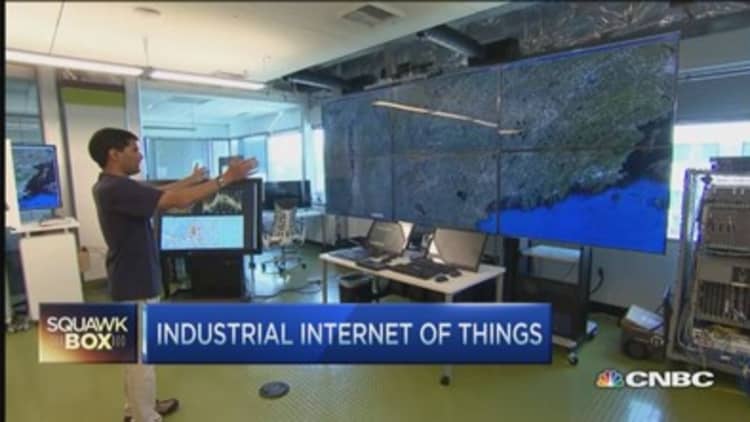
It's being called the industrial Internet of things (IIoT), an emerging business at the intersection of hi-technology and big machinery.
The concept is simple: making industrial machines smarter, through the adoption of sensors, software and big data analytics. As consumers become increasingly reliant on the information provided by mobile devices and smart technology, IIoT seeks to do the same for business by streamlining operations and making them more efficient.
To be sure, the industrial Internet is very much in its infancy. Yet a report by Accenture says the potential economic impact of industrial web spending is huge: IIoT expenditures may reach $500 billion by 2020, and could even add $15 trillion to global growth by 2030. Companies from a wide spectrum of industries such as oil, mining and agriculture, are dedicating resources to the concept.
General Electric, meanwhile, is one of the companies at the forefront. Since 2012, the industrial giant has poured billions of dollars into the burgeoning space, which is called, simply, the Industrial Internet.
For GE, the industrial Internet generated just over $1 billion in revenue last year, a tiny 1 percent fraction of its $107 billion in industrial sales. Still, the company has high hopes for growth prospects.
"We started with this idea that the world of software and machines was really coming together, and we felt that software was going to transform industrial machines," said Bill Ruh, vice president of the GE Software Center.
Startup on steriods
GE's Software Center has the look and feel of a start-up on steroids. Based in the Bay Area, its glossy open-workspace building is stocked with food and buzzes with the energy of more than 1,000 software developers and engineers.
There, the company develops its IIoT offerings, including an operating software platform called Predix, which caters to machines in a range of industries, helping companies to save billions.
One application assesses oil and gas pipelines for environmental risks to prevent possible leaks, while another gathers flight data for GE jet engines in use, plotted out in colorful, easy-to-read dot graphs.
There are apps to help freight railroad operators anticipate when trains may be blown over by a strong gust of wind. Meanwhile, low-flying drones keep track of locomotives' inspections.
Within the center, researchers use consumer electronics as hardware platforms upon which they build software. Some of the newest projects center around augmented reality, equipping Google Glass, Oculus Rift, and Goldeneye headsets with software to make factory inspections easier and faster. Predix itself functions on laptops, tablets and mobile devices.
According to Ruh, this type of increased efficiency has major import for energy companies in general, and oil refineries in particular.
"In the energy space, it's quite clear," Ruh said. "If I can get to total efficiency, there's just so much upside in what they have, that small gains are big numbers."
The savings can be notable in power generation, as well. One percent more fuel efficiency on a gas turbine fleet can result in upwards of $6 billion in fuel savings per year, according to GE data. Software-connected sensors in turbines on a wind farm can generate between 5 to 10 percent more power, translating into a 20 percent boost in profitability.
Spending big, thinking bigger
Although IIoT is still in its early stages, GE and other market participants are thinking big. The industrial giant has partnerships with AT&T, Verizon, Softbank, Cisco and Intel, among others.
Agriculture behemoth Monsanto recently got in on the act by acquiring a software company that provides weather predictions; and equipment company Komatsu is creating autonomous equipment for the mining sector.
"The potential to improve sales, improve operations and manage risk is the key to new business models for these large companies [including GE]," said Ed Maguire, managing director for CLSA Americas.
Still, there are risks. Cybersecurity remains a primary concern, both for the companies developing the software and their prospective customers.
"One of the challenges of opening up these operational technologies to information technology is that operation tech was often designed to be closed to the outside," Maguire said.
"If something fails, someone dies. So if your IT system goes down, now people don't get that email," he added.



